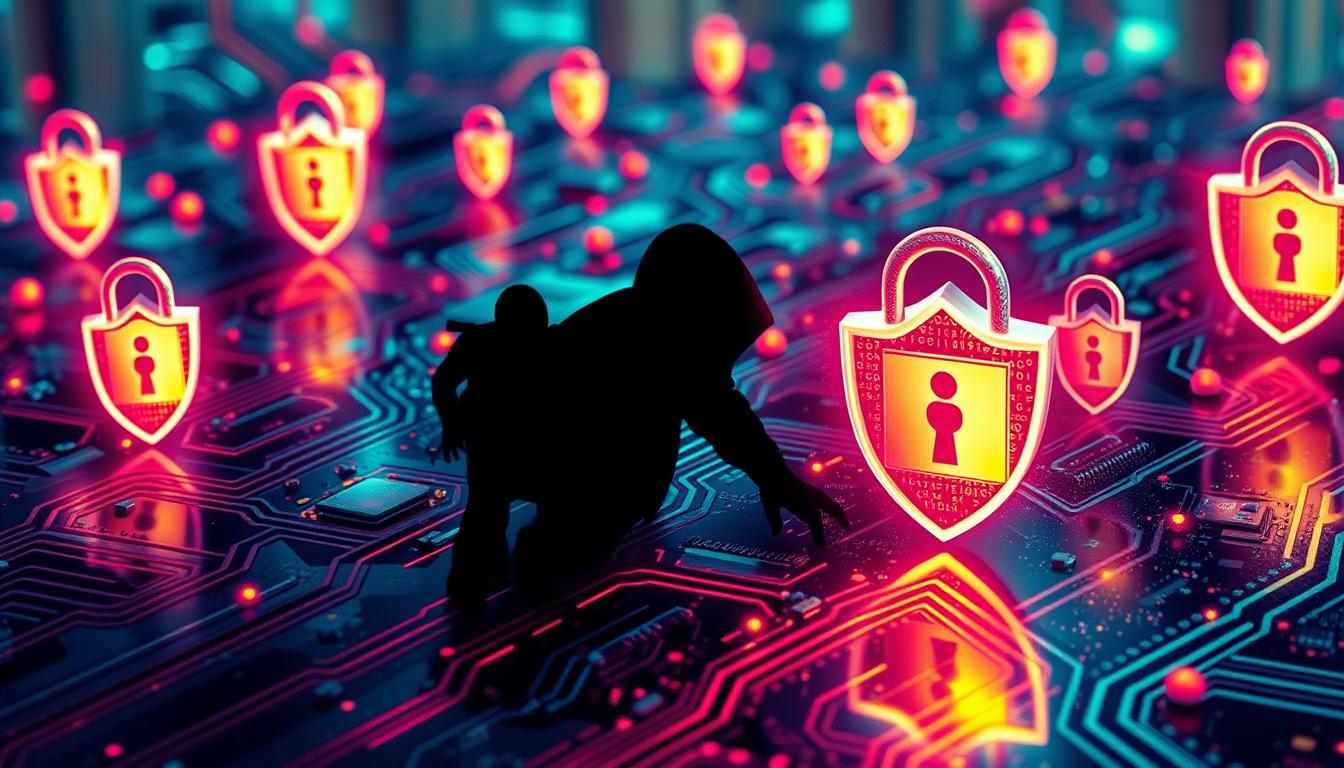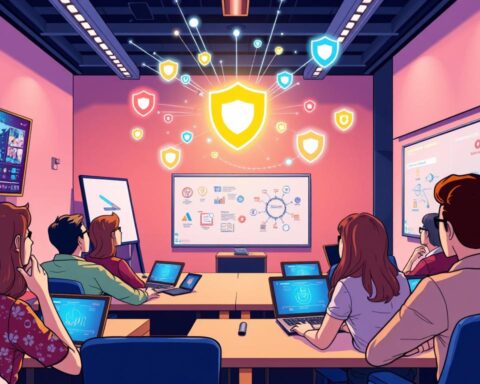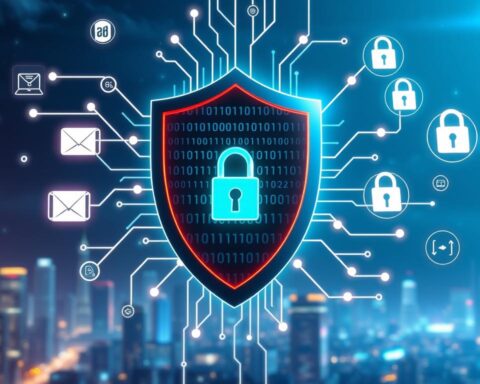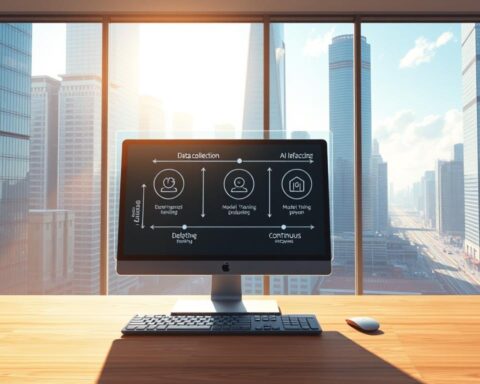Did you know that 5.4 billion malware attacks happen every year? That’s 171 attacks every second. This is a constant threat to our digital world1. Welcome to Day 9 of our Cybersecurity Training. We’ll explore malware analysis and cyber threats.
Malware, short for malicious software, is a big problem. It’s designed to harm computer systems. Knowing about malware is key for keeping safe online. This guide will teach you how to spot and fight different types of malware.
In 2022, malware made up 17% of cyberattacks, along with phishing and ransomware1. We’ll look at viruses, worms, and ransomware. You’ll learn how to stop these threats.
By the end of this guide, you’ll know a lot about malware. You’ll be ready to protect your digital stuff. Let’s start this journey to improve our online safety and outsmart cyber criminals.
Key Takeaways
- Malware attacks occur 5.4 billion times annually worldwide
- Malware constitutes 17% of all cyberattacks
- Viruses are the most common type of malware
- Multi-factor authentication (MFA) prevents 99.9% of automated malware attacks
- Security awareness training is key for stopping malware
- Keeping up with updates is vital for fighting new threats
What is Malware: Definition and Historical Evolution
Malware is short for malicious software. It’s any program made to harm or exploit computer systems. Over decades, it has grown from simple pranks to complex threats that test today’s network security.
Origins and Early Development
The first malware, Creeper, was made in the 1970s. It spread across ARPANET, showing a playful message: “I’M THE CREEPER: CATCH ME IF YOU CAN.” This early program set the stage for future malware detection challenges.
In the 1980s, computer viruses started. Elk Cloner infected Apple II systems in 1982, becoming the first virus2. Brain was the first PC-based malware in 19862. These events marked the beginning of a new era in cybersecurity threats.
The 1990s saw a rise in email viruses, with Microsoft Windows becoming the top operating system. This period saw more complex malware, making data protection needs grow2.
The millennium brought new challenges. The Morris worm hit about 10% of all networked computers, and Melissa affected one million email accounts and over 100,000 computers3. These incidents showed the need for strong malware detection systems.
“The evolution of malware mirrors the advancement of technology itself, constantly adapting to exploit new vulnerabilities and challenge our defenses.”
Today, malware is a big threat. Billions of attacks happen every year, hitting both businesses and individuals3. With threats like ransomware increasing by 365% in 20194, staying vigilant in our network security is more important than ever.
| Decade | Key Developments | Notable Malware |
|---|---|---|
| 1970s | First self-replicating program | Creeper |
| 1980s | First computer viruses | Elk Cloner, Brain |
| 1990s | Rise of email viruses | Melissa |
| 2000s | Increased sophistication, web-based attacks | ILOVEYOU, Mydoom |
| 2010s-Present | Advanced threats, mobile malware | Ransomware, IoT malware |
Understanding Malware: How It Works and How to Prevent It
Malware is a big threat to our digital world. In 2023, attacks went up by 30% from the year before5. It can harm many devices, from computers to phones and servers6.
The first step in getting infected is when malware gets into a device. This usually happens when someone clicks on something they shouldn’t. Sadly, 95% of security breaches are because of human mistakes5.
Email is a main way malware spreads. About 92% of malware comes through emails7. Phishing emails often come before ransomware, tricking people into clicking on bad links6.
To fight these threats, we need to follow good cybersecurity habits. Teaching employees about security can cut phishing attacks by up to 70%7. Also, making networks smaller can block malware from spreading7.
| Malware Type | Characteristics | Prevention Strategy |
|---|---|---|
| Viruses | Self-replicating, attaches to files | Updated antivirus software |
| Ransomware | Encrypts data, demands payment | Regular backups, email filtering |
| Trojans | Disguised as legitimate software | Caution when downloading, application whitelisting |
| Spyware | Covertly collects user data | Anti-spyware tools, regular scans |
Using these strategies is key. In 2022, fixing a malware attack cost businesses about $2.4 million5. By focusing on security and education, we can better protect our digital world.
Common Types of Malware and Their Characteristics
Malware is a big threat to our digital world. Knowing about different types of malware helps us protect our computers better.
Viruses and Worms
Viruses and worms spread fast. Viruses hide in good programs, while worms copy themselves. The WannaCry worm, for example, hit nearly 5 million devices in 150 countries in two years8.
This shows how important it is to have strong security online.
Trojans and Ransomware
Trojans look like real software but are not. Ransomware locks your files and asks for money to unlock them. About 40% of malware attacks are ransomware, costing a lot9.
The city of Baltimore lost over $18 million to a ransomware attack10.
Spyware and Adware
Spyware secretly takes your personal info. Adware shows ads you don’t want. About 30% of malware is spyware, aiming for your money info9.
In 2017, Fireball adware infected 250 million computers, changing browsers and tracking you10.
Rootkits and Keyloggers
Rootkits let hackers into your system. Keyloggers record what you type, like passwords. The first rootkit, NTRootkit, came out in 19998.
Today, keyloggers like Olympic Vision can be bought for $25, a big risk for businesses10.
| Malware Type | Key Characteristic | Notable Example |
|---|---|---|
| Virus | Attaches to legitimate programs | Zeus (2006) |
| Worm | Self-replicating | WannaCry |
| Trojan | Disguises as legitimate software | Emotet |
| Ransomware | Encrypts data for ransom | REvil |
| Spyware | Collects user information | Pegasus |
| Adware | Displays unwanted ads | Fireball |
| Rootkit | Provides unauthorized system access | Hacker Defender |
| Keylogger | Records keystrokes | Agent Tesla |
It’s key to know about malware to keep our computers safe. Keeping antivirus software up to date and training employees is vital. Without current protection, businesses are 5 times more likely to get infected9.
Initial Infection Vectors and Propagation Methods
Malware analysis shows a complex world of cyber threats. In 2023, exploits were the main way attacks started, making up 38% of them11. Phishing attacks caused 17% of infections, while old compromises and stolen passwords were responsible for 15% and 10% respectively11.
Email is a big way malware spreads, with 94% of it coming through email12. This shows how important it is to keep email safe. Companies that train their teams well see a 70% drop in phishing success12.
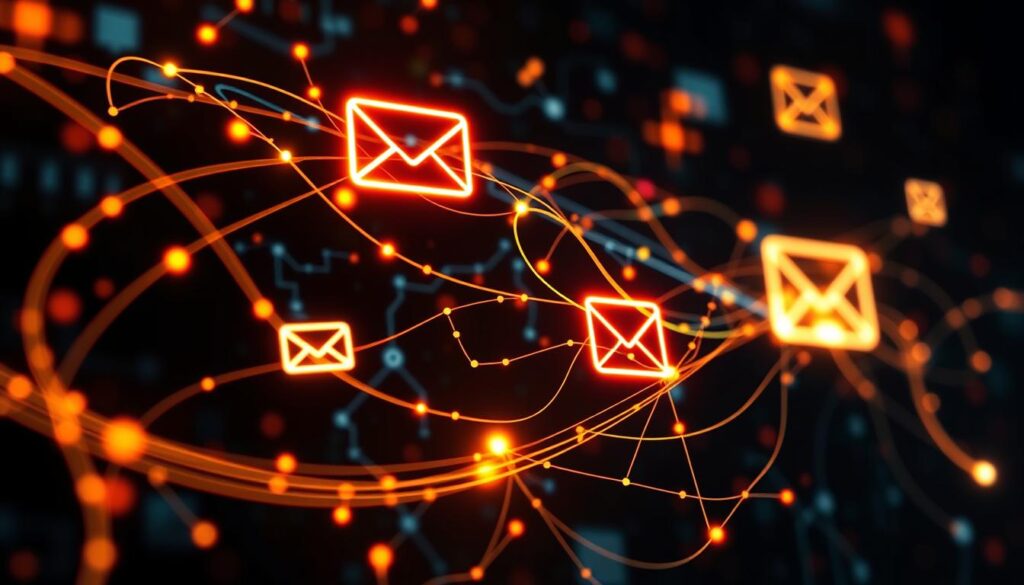
How malware spreads has changed a lot. The ILOVEYOU worm in 2000 caused over $15 billion in damage. The SQL Slammer worm in 2003 stopped internet traffic fast11. Today, threats like Ryuk ransomware target places like healthcare and government11.
Malware spreading fast is a big problem for cybersecurity. Some malware can spread in just one minute12. This fast spread, along with 52% of malware attacks aiming to steal data, shows we need strong network security now12.
| Infection Vector | Percentage |
|---|---|
| Exploits | 38% |
| Phishing | 17% |
| Prior Compromises | 15% |
| Stolen Credentials | 10% |
| Brute Force Attacks | 6% |
As cyber threats grow, so must our defenses. Knowing how malware spreads helps us fight it better. This keeps our digital world safe.
Advanced Malware Attack Techniques
Cybercriminals are getting smarter, making malware threats more complex. It’s vital for companies to understand these new tactics. This knowledge helps in detecting malware and keeping systems safe.
Polymorphic Malware
Polymorphic malware changes its code to avoid detection. This makes it hard for old antivirus software to catch. Companies that watch files closely find more tampering or data issues, up by 25%13.
Only about 50% of advanced malware is caught by static file analysis. This shows we need better ways to find these threats13.
Fileless Malware Attacks
Fileless malware works in memory, leaving no disk trace. These attacks have jumped by 265% in just three years14. Sandboxes can catch 70% of malware, helping to fight these sneaky threats13.
Zero-day Exploits
Zero-day exploits use unknown software or system weaknesses. Advanced malware protection is key to fighting these. Machine learning can spot unknown malware 60% better13.
| Attack Technique | Detection Challenge | Mitigation Strategy |
|---|---|---|
| Polymorphic Malware | Constantly changing code | Dynamic monitoring, AI-based detection |
| Fileless Malware | No disk footprint | Behavioral analysis, memory scanning |
| Zero-day Exploits | Unknown vulnerabilities | Machine learning, regular patching |
Companies that teach employees about cybersecurity see a 70% drop in phishing attacks. This shows how important people are in keeping systems safe14. A mix of security layers can cut malware risks by 50%, proving diverse protection is essential14.
“Effective malware detection requires a combination of advanced technologies and informed human vigilance.”
The cost of a malware attack for businesses is about $2.4 million. This includes recovery costs, lost sales, and damage to reputation14. It’s clear that companies must keep learning and investing in top-notch cybersecurity to stay ahead.
Essential Malware Prevention Strategies
Keeping your organization safe from cyber threats needs a mix of strategies. Let’s look at key ways to improve your cybersecurity and protect your data.
Security Policies Implementation
Creating strong security policies is key to stopping threats. These policies should cover how to handle passwords, data, and network access. Using strong passwords with letters, numbers, and symbols can help fight off brute force attacks15.
Also, keeping your software up to date is important. Microsoft’s Patch Tuesday updates often include security fixes15.
Employee Training Programs
Teaching your staff is critical, as most cyber attacks start with phishing emails or links15. Good training can help prevent malware infections. Most malware comes through emails, making them a big risk for businesses16.
Technical Controls
Setting up technical defenses is key for full protection. Using Multi-factor Authentication (MFA) adds extra steps to log in, making accounts safer15. Regular scans for viruses and malware are important to catch hidden threats15.
Firewalls help block unauthorized access and keep data safe15. Backing up important data regularly can help recover from cyber attacks15. Encrypting data in transit and storage, like in cloud services, adds an extra layer of security15.
These steps are vital, as 60% of small businesses fail after a cyber attack16.
By taking these steps, you can better protect your data from malware. Remember, keeping your systems safe is an ongoing task that needs constant attention and updates in the fast-changing world of cybersecurity.
Detection and Response to Malware Incidents
Malware is a big threat in our digital world. Every day, 450,000 new types of malware appear. There are over one billion malware programs out there now17.
Malware analysis is key to fighting these threats. AI-driven algorithms can spot malware over 90% of the time. This beats old antivirus methods18. Catching malware early can stop up to 95% of infections18.
Network security is vital against malware. About 70% of companies use endpoint detection and response (EDR) tools to stay safe18. These tools watch over devices on the network and catch threats before they hit19.
Cybersecurity experts use many ways to find and fight malware:
- Heuristic analysis to spot new malware
- Sandboxing to safely test software
- Machine learning to find patterns in software
- Keeping software up to date to fix holes
- Using more than one way to log in to keep out hackers
Quick action is key when malware hits. It takes companies 207 days to find a breach and 73 more days to stop it18. A good plan and tools like SentinelOne can cut these times and lessen harm19.
Teaching employees is also very important. Seventy percent of IT security pros say bad user habits cause most breaches. This shows how vital teaching is, along with tech solutions18.
| Malware Detection Method | Effectiveness |
|---|---|
| Traditional Antivirus | ~50% detection rate |
| AI-driven Algorithms | >90% detection rate |
| Endpoint Detection and Response | 70% adoption rate |
By using these advanced methods, companies can greatly boost their cybersecurity. This helps fight the growing threat of malware attacks.
Mobile Device Malware Security
Mobile devices are now a big target for hackers, making our world more vulnerable20. More people use their phones to get to work stuff and personal info, which means more chances for hackers to get in2120.
Mobile-Specific Threats
Malware often gets into phones through bad apps from unofficial stores21. Android phones are more likely to get malware than others20. Ransomware is a big worry, as it can lock you out or demand money for your data20.
Spyware sneaks up on you and takes your personal info without asking, and worms spread fast through messages or Bluetooth20. Banking malware tricks you into giving away your financial info, looking like real banking apps20.
Protection Strategies for Mobile Devices
Having strong antivirus software is key to keep your phone safe. Keeping your phone’s software up to date is also important to avoid hacker attacks21.
Using VPNs when you’re on public Wi-Fi is a good idea to keep your data safe21. Teaching your team about phone safety and setting strict rules can help a lot21.
| Threat Type | Description | Protection Strategy |
|---|---|---|
| Malicious Apps | Apps containing hidden malware | Download only from official app stores |
| Phishing Attacks | Deceptive emails or SMS messages | Employee training on identifying phishing attempts |
| Unsecured Wi-Fi | Public networks vulnerable to attacks | Use of VPNs for secure connections |
| OS Vulnerabilities | Unpatched security flaws in mobile OS | Regular system updates and patches |
Knowing about these threats and taking steps to protect your data can keep your info safe on all your devices.
Enterprise-Level Malware Protection
Big companies have to protect their digital stuff from malware. Every minute, 12 companies get hit by ransomware. So, they really need strong protection22. This part talks about how to keep malware away.
Network Security Measures
Network security is key for keeping malware out. Next-generation firewalls and intrusion systems are very important23. Companies like Palo Alto Networks, Fortinet, and Cisco have great tools to protect networks23.
Splitting your network into parts is also smart. It stops malware from spreading. This way, you can keep important stuff safe.
Endpoint Protection Solutions
Tools like Endpoint Detection and Response (EDR) find and stop threats. They use smart tech to catch bad stuff23. Big names like Crowdstrike, FireEye, and SentinelOne lead in this field23. These tools watch your devices all the time and act fast.
If you don’t have experts, Managed Detection and Response (MDR) services can help. They watch for threats all day, every day23.
Incident Response Planning
Having a good plan for when malware hits is very important. This includes:
- Regular backups to get your data back
- Always watching for strange activity
- Teaching employees about staying safe online
Using strong identity systems also helps. It makes it harder for hackers to get in23. Companies like Okta, Auth0, and Duo Security are leaders in this area23.
By using these strategies, big companies can fight malware better. They can keep working even when cyber threats come.
| Protection Layer | Key Components | Benefits |
|---|---|---|
| Network Security | NGFW, Segmentation | Perimeter defense, Threat containment |
| Endpoint Protection | EDR, MDR | Real-time monitoring, Rapid response |
| Incident Response | Backups, Training | Data recovery, Threat awareness |
Conclusion
Understanding malware and how to prevent it is key in today’s digital world. Malware is a big problem, with almost 90% coming from downloads that seem safe. Over 50% of infections start with email or text message links24. This can really slow down your system, causing a 30% drop in performance24.
Cybersecurity is essential, as data breaches cost a lot. In 2023, the global average cost was $4.45 million25. Companies are at risk, with 61% facing ransomware attacks in 2022. These attacks cost an average of $1.85 million25. With over 350,000 new malware variants found every day25, the threat is always growing.
To fight malware, we need to act early. Regular scans can cut infection risks by 70%24. Teaching users about phishing emails is also important. By using strong security, staying updated, and promoting cybersecurity awareness, we can make the internet safer for everyone.
FAQ
What is malware and how does it work?
What are the most common types of malware?
How can I protect my devices from malware?
What are the signs that my device might be infected with malware?
How does malware spread across networks?
What is a zero-day exploit?
How can businesses protect themselves from enterprise-level malware attacks?
What is fileless malware and why is it dangerous?
How can I protect my mobile devices from malware?
What role does employee training play in malware prevention?
Source Links
- What is Malware? How to Prevent Malware Attacks? | Fortinet – https://www.fortinet.com/resources/cyberglossary/malware
- What Is Malware – How to Prevent and Remove It | Cybersecurity | CompTIA – https://www.comptia.org/content/articles/what-is-malware
- The History of Malware | IBM – https://www.ibm.com/think/topics/malware-history
- What is Malware? Malware Definition, Types and Protection – https://www.malwarebytes.com/malware
- Malware: How To Protect Against, Detect, and Remove It – https://consumer.ftc.gov/articles/malware-how-protect-against-detect-and-remove-it
- Understanding, recognizing and preventing malware | Cybersecurity – https://www.nrsforu.com/rsc-web-preauth/resource-center/cybersecurity/articles/understanding-recognizing-preventing-malware
- Malware – https://www.illumio.com/cybersecurity-101/malware
- 12 Common Types of Malware Attacks and How to Prevent Them – https://www.techtarget.com/searchsecurity/tip/10-common-types-of-malware-attacks-and-how-to-prevent-them
- What Is Malware? – Definition and Examples – https://www.cisco.com/site/us/en/learn/topics/security/what-is-malware.html
- 12 Types of Malware + Examples That You Should Know – https://www.crowdstrike.com/en-us/cybersecurity-101/malware/types-of-malware/
- Malware explained: How to prevent, detect and recover from it – https://www.csoonline.com/article/565999/what-is-malware-viruses-worms-trojans-and-beyond.html
- What Is a Malware Attack? Definition & Best Practices | Rapid7 – https://www.rapid7.com/fundamentals/malware-attacks/
- Malware Detection: 10 Techniques | CrowdStrike – https://www.crowdstrike.com/en-us/cybersecurity-101/malware/malware-detection/
- How to Prevent a Malware Attack | Ascendant – https://ascendantusa.com/2025/01/08/how-to-prevent-a-malware-attack/
- How to Prevent Malware: 15 Best Practices for Malware Prevention – https://www.esecurityplanet.com/threats/how-to-prevent-malware/
- What is Malware? Malware Prevention | Darktrace – https://darktrace.com/cyber-ai-glossary/malware
- What is Malware Detection? | Splunk – https://www.splunk.com/en_us/blog/learn/malware-detection.html
- What is Malware Detection? | Malware Detection Explained – https://www.xcitium.com/resources/knowledge-base/malware-detection/
- What is Malware Detection? Importance & Techniques – https://www.sentinelone.com/cybersecurity-101/threat-intelligence/what-is-malware-detection/
- What is Mobile Malware – All You Need to Know – https://amatas.com/blog/what-is-mobile-malware-all-you-need-to-know/
- 5 Ways Your Mobile Device Can Get Malware – https://www.securitymetrics.com/blog/5-ways-your-mobile-device-can-get-malware
- Malware Protection – How Does It Work? – Check Point Software – https://www.checkpoint.com/cyber-hub/threat-prevention/what-is-malware/malware-protection-how-does-it-work/
- Enterprise Malware Protection: How to Build the Ideal Security Stack – https://www.byos.io/blog/enterprise-malware-protection
- What is malware: How to protect yourself – Get Cyber Safe – https://www.getcybersafe.gc.ca/en/blogs/what-malware-how-protect-yourself
- Understanding Malware- A Comprehensive Guide – https://www.iosentrix.com/blog/understanding-malware-a-comprehensive-guide
